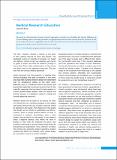Please use this identifier to cite or link to this item:
https://hdl.handle.net/20.500.14356/1082Full metadata record
| DC Field | Value | Language |
|---|---|---|
| dc.contributor.author | Baral, Gehanath | - |
| dc.date.accessioned | 2023-04-23T07:06:37Z | - |
| dc.date.available | 2023-04-23T07:06:37Z | - |
| dc.date.issued | 2021 | - |
| dc.identifier.citation | BaralG. (2021). Medical Research Education. Journal of Nepal Health Research Council, 19(2), i-ii. https://doi.org/10.33314/jnhrc.v19i2.3827 | en_US |
| dc.identifier.issn | JNHRC Print ISSN: 1727-5482; Online ISSN: 1999-6217 | - |
| dc.identifier.uri | http://103.69.126.140:8080/handle/20.500.14356/1082 | - |
| dc.description | Editorial | en_US |
| dc.description.abstract | Abstract Research for clinical practice becomes robust if appropriate researchers are identified and trained. Utilization of research findings and its ownership can assure the appropriateness and real time research in society. Research on felt need would carry the better applicability than the observed need by external researcher. Thus the structured education program in medical research would be worth to start with. Keywords: Education program; medical research; research gap | en_US |
| dc.language.iso | en | en_US |
| dc.publisher | Nepal Health Research Council | en_US |
| dc.relation.ispartofseries | Apr-June, 2021;3827 | - |
| dc.subject | Education program | en_US |
| dc.subject | Medical research | en_US |
| dc.subject | Research gap | en_US |
| dc.title | Medical Research Education | en_US |
| dc.type | Journal Article | en_US |
| local.journal.category | Editorial | - |
| Appears in Collections: | Vol. 19 No. 2 (2021): Vol 19 No 2 Issue 51 Apr-Jun 2021 | |
Files in This Item:
| File | Description | Size | Format | |
|---|---|---|---|---|
| 3827-Manuscript-23754-1-10-20210907.pdf | 142.25 kB | Adobe PDF |  View/Open |
Items in DSpace are protected by copyright, with all rights reserved, unless otherwise indicated.
